Xiangyu Li
Profit Mirage: Revisiting Information Leakage in LLM-based Financial Agents
Oct 09, 2025Abstract:LLM-based financial agents have attracted widespread excitement for their ability to trade like human experts. However, most systems exhibit a "profit mirage": dazzling back-tested returns evaporate once the model's knowledge window ends, because of the inherent information leakage in LLMs. In this paper, we systematically quantify this leakage issue across four dimensions and release FinLake-Bench, a leakage-robust evaluation benchmark. Furthermore, to mitigate this issue, we introduce FactFin, a framework that applies counterfactual perturbations to compel LLM-based agents to learn causal drivers instead of memorized outcomes. FactFin integrates four core components: Strategy Code Generator, Retrieval-Augmented Generation, Monte Carlo Tree Search, and Counterfactual Simulator. Extensive experiments show that our method surpasses all baselines in out-of-sample generalization, delivering superior risk-adjusted performance.
QuantAgents: Towards Multi-agent Financial System via Simulated Trading
Oct 06, 2025Abstract:In this paper, our objective is to develop a multi-agent financial system that incorporates simulated trading, a technique extensively utilized by financial professionals. While current LLM-based agent models demonstrate competitive performance, they still exhibit significant deviations from real-world fund companies. A critical distinction lies in the agents' reliance on ``post-reflection'', particularly in response to adverse outcomes, but lack a distinctly human capability: long-term prediction of future trends. Therefore, we introduce QuantAgents, a multi-agent system integrating simulated trading, to comprehensively evaluate various investment strategies and market scenarios without assuming actual risks. Specifically, QuantAgents comprises four agents: a simulated trading analyst, a risk control analyst, a market news analyst, and a manager, who collaborate through several meetings. Moreover, our system incentivizes agents to receive feedback on two fronts: performance in real-world markets and predictive accuracy in simulated trading. Extensive experiments demonstrate that our framework excels across all metrics, yielding an overall return of nearly 300% over the three years (https://quantagents.github.io/).
T2R-bench: A Benchmark for Generating Article-Level Reports from Real World Industrial Tables
Aug 27, 2025Abstract:Extensive research has been conducted to explore the capabilities of large language models (LLMs) in table reasoning. However, the essential task of transforming tables information into reports remains a significant challenge for industrial applications. This task is plagued by two critical issues: 1) the complexity and diversity of tables lead to suboptimal reasoning outcomes; and 2) existing table benchmarks lack the capacity to adequately assess the practical application of this task. To fill this gap, we propose the table-to-report task and construct a bilingual benchmark named T2R-bench, where the key information flow from the tables to the reports for this task. The benchmark comprises 457 industrial tables, all derived from real-world scenarios and encompassing 19 industry domains as well as 4 types of industrial tables. Furthermore, we propose an evaluation criteria to fairly measure the quality of report generation. The experiments on 25 widely-used LLMs reveal that even state-of-the-art models like Deepseek-R1 only achieves performance with 62.71 overall score, indicating that LLMs still have room for improvement on T2R-bench. Source code and data will be available after acceptance.
Boosting Micro-Expression Analysis via Prior-Guided Video-Level Regression
Aug 26, 2025Abstract:Micro-expressions (MEs) are involuntary, low-intensity, and short-duration facial expressions that often reveal an individual's genuine thoughts and emotions. Most existing ME analysis methods rely on window-level classification with fixed window sizes and hard decisions, which limits their ability to capture the complex temporal dynamics of MEs. Although recent approaches have adopted video-level regression frameworks to address some of these challenges, interval decoding still depends on manually predefined, window-based methods, leaving the issue only partially mitigated. In this paper, we propose a prior-guided video-level regression method for ME analysis. We introduce a scalable interval selection strategy that comprehensively considers the temporal evolution, duration, and class distribution characteristics of MEs, enabling precise spotting of the onset, apex, and offset phases. In addition, we introduce a synergistic optimization framework, in which the spotting and recognition tasks share parameters except for the classification heads. This fully exploits complementary information, makes more efficient use of limited data, and enhances the model's capability. Extensive experiments on multiple benchmark datasets demonstrate the state-of-the-art performance of our method, with an STRS of 0.0562 on CAS(ME)$^3$ and 0.2000 on SAMMLV. The code is available at https://github.com/zizheng-guo/BoostingVRME.
SCIRGC: Multi-Granularity Citation Recommendation and Citation Sentence Preference Alignment
May 26, 2025Abstract:Citations are crucial in scientific research articles as they highlight the connection between the current study and prior work. However, this process is often time-consuming for researchers. In this study, we propose the SciRGC framework, which aims to automatically recommend citation articles and generate citation sentences for citation locations within articles. The framework addresses two key challenges in academic citation generation: 1) how to accurately identify the author's citation intent and find relevant citation papers, and 2) how to generate high-quality citation sentences that align with human preferences. We enhance citation recommendation accuracy in the citation article recommendation module by incorporating citation networks and sentiment intent, and generate reasoning-based citation sentences in the citation sentence generation module by using the original article abstract, local context, citation intent, and recommended articles as inputs. Additionally, we propose a new evaluation metric to fairly assess the quality of generated citation sentences. Through comparisons with baseline models and ablation experiments, the SciRGC framework not only improves the accuracy and relevance of citation recommendations but also ensures the appropriateness of the generated citation sentences in context, providing a valuable tool for interdisciplinary researchers.
Benchmarking AI scientists in omics data-driven biological research
May 13, 2025Abstract:The rise of large language models and multi-agent systems has sparked growing interest in AI scientists capable of autonomous biological research. However, existing benchmarks either focus on reasoning without data or on data analysis with predefined statistical answers, lacking realistic, data-driven evaluation settings. Here, we introduce the Biological AI Scientist Benchmark (BaisBench), a benchmark designed to assess AI scientists' ability to generate biological discoveries through data analysis and reasoning with external knowledge. BaisBench comprises two tasks: cell type annotation on 31 expert-labeled single-cell datasets, and scientific discovery through answering 198 multiple-choice questions derived from the biological insights of 41 recent single-cell studies. Systematic experiments on state-of-the-art AI scientists and LLM agents showed that while promising, current models still substantially underperform human experts on both tasks. We hope BaisBench will fill this gap and serve as a foundation for advancing and evaluating AI models for scientific discovery. The benchmark can be found at: https://github.com/EperLuo/BaisBench.
Time's Up! An Empirical Study of LLM Reasoning Ability Under Output Length Constraint
Apr 22, 2025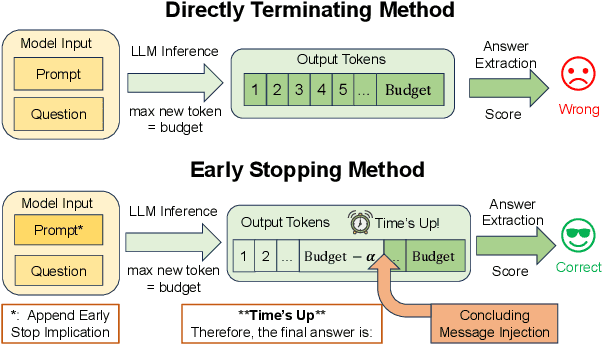
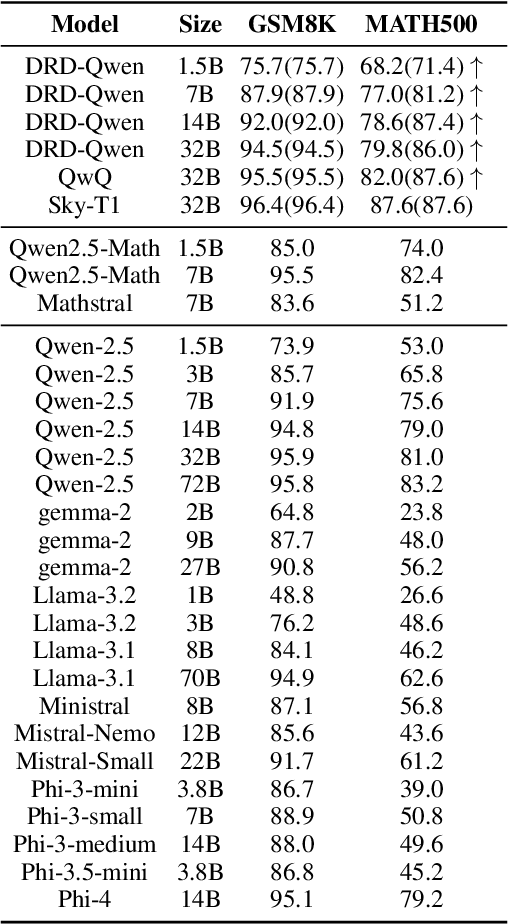
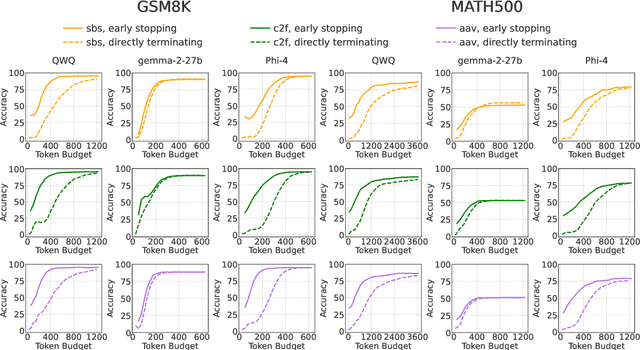
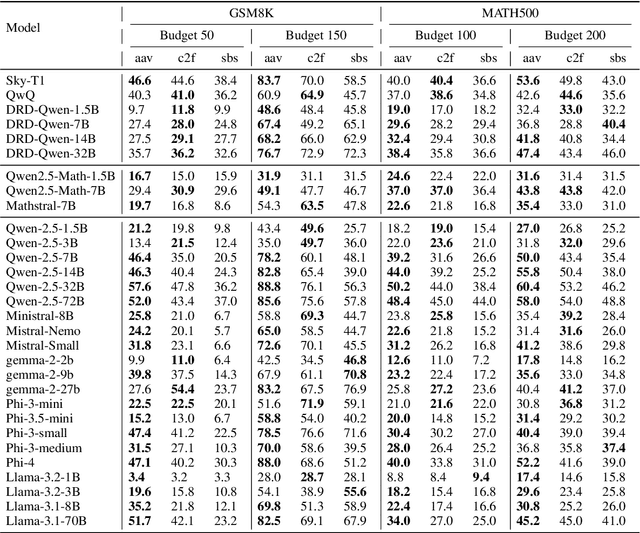
Abstract:Recent work has demonstrated the remarkable potential of Large Language Models (LLMs) in test-time scaling. By making the models think before answering, they are able to achieve much higher accuracy with extra inference computation. However, in many real-world scenarios, models are used under time constraints, where an answer should be given to the user within a certain output length. It is unclear whether and how the reasoning abilities of LLMs remain effective under such constraints. We take a first look at this problem by conducting an in-depth empirical study. Specifically, we test more than 25 LLMs on common reasoning datasets under a wide range of output length budgets, and we analyze the correlation between the inference accuracy and various properties including model type, model size, prompt style, etc. We also consider the mappings between the token budgets and the actual on-device latency budgets. The results have demonstrated several interesting findings regarding the budget-aware LLM reasoning that differ from the unconstrained situation, e.g. the optimal choices of model sizes and prompts change under different budgets. These findings offer practical guidance for users to deploy LLMs under real-world latency constraints.
Adaptive Wavelet Filters as Practical Texture Feature Amplifiers for Parkinson's Disease Screening in OCT
Mar 25, 2025Abstract:Parkinson's disease (PD) is a prevalent neurodegenerative disorder globally. The eye's retina is an extension of the brain and has great potential in PD screening. Recent studies have suggested that texture features extracted from retinal layers can be adopted as biomarkers for PD diagnosis under optical coherence tomography (OCT) images. Frequency domain learning techniques can enhance the feature representations of deep neural networks (DNNs) by decomposing frequency components involving rich texture features. Additionally, previous works have not exploited texture features for automated PD screening in OCT. Motivated by the above analysis, we propose a novel Adaptive Wavelet Filter (AWF) that serves as the Practical Texture Feature Amplifier to fully leverage the merits of texture features to boost the PD screening performance of DNNs with the aid of frequency domain learning. Specifically, AWF first enhances texture feature representation diversities via channel mixer, then emphasizes informative texture feature representations with the well-designed adaptive wavelet filtering token mixer. By combining the AWFs with the DNN stem, AWFNet is constructed for automated PD screening. Additionally, we introduce a novel Balanced Confidence (BC) Loss by mining the potential of sample-wise predicted probabilities of all classes and class frequency prior, to further boost the PD screening performance and trustworthiness of AWFNet. The extensive experiments manifest the superiority of our AWFNet and BC over state-of-the-art methods in terms of PD screening performance and trustworthiness.
Iterative Optimal Attention and Local Model for Single Image Rain Streak Removal
Mar 20, 2025Abstract:High-fidelity imaging is crucial for the successful safety supervision and intelligent deployment of vision-based measurement systems (VBMS). It ensures high-quality imaging in VBMS, which is fundamental for reliable visual measurement and analysis. However, imaging quality can be significantly impaired by adverse weather conditions, particularly rain, leading to blurred images and reduced contrast. Such impairments increase the risk of inaccurate evaluations and misinterpretations in VBMS. To address these limitations, we propose an Expectation Maximization Reconstruction Transformer (EMResformer) for single image rain streak removal. The EMResformer retains the key self-attention values for feature aggregation, enhancing local features to produce superior image reconstruction. Specifically, we propose an Expectation Maximization Block seamlessly integrated into the single image rain streak removal network, enhancing its ability to eliminate superfluous information and restore a cleaner background image. Additionally, to further enhance local information for improved detail rendition, we introduce a Local Model Residual Block, which integrates two local model blocks along with a sequence of convolutions and activation functions. This integration synergistically facilitates the extraction of more pertinent features for enhanced single image rain streak removal. Extensive experiments validate that our proposed EMResformer surpasses current state-of-the-art single image rain streak removal methods on both synthetic and real-world datasets, achieving an improved balance between model complexity and single image deraining performance. Furthermore, we evaluate the effectiveness of our method in VBMS scenarios, demonstrating that high-quality imaging significantly improves the accuracy and reliability of VBMS tasks.
RAD: Training an End-to-End Driving Policy via Large-Scale 3DGS-based Reinforcement Learning
Feb 18, 2025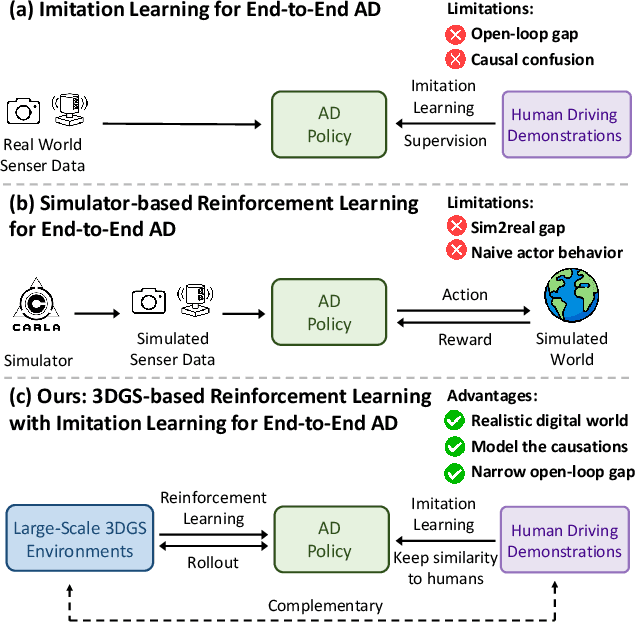

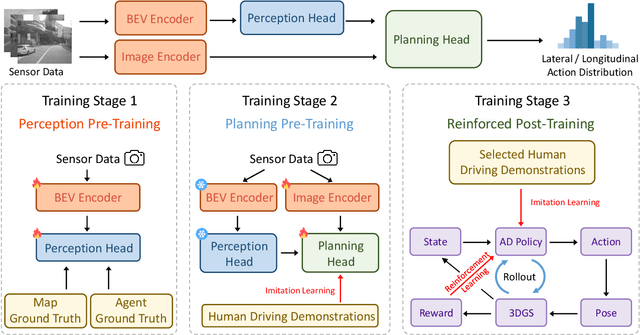

Abstract:Existing end-to-end autonomous driving (AD) algorithms typically follow the Imitation Learning (IL) paradigm, which faces challenges such as causal confusion and the open-loop gap. In this work, we establish a 3DGS-based closed-loop Reinforcement Learning (RL) training paradigm. By leveraging 3DGS techniques, we construct a photorealistic digital replica of the real physical world, enabling the AD policy to extensively explore the state space and learn to handle out-of-distribution scenarios through large-scale trial and error. To enhance safety, we design specialized rewards that guide the policy to effectively respond to safety-critical events and understand real-world causal relationships. For better alignment with human driving behavior, IL is incorporated into RL training as a regularization term. We introduce a closed-loop evaluation benchmark consisting of diverse, previously unseen 3DGS environments. Compared to IL-based methods, RAD achieves stronger performance in most closed-loop metrics, especially 3x lower collision rate. Abundant closed-loop results are presented at https://hgao-cv.github.io/RAD.
 Add to Chrome
Add to Chrome Add to Firefox
Add to Firefox Add to Edge
Add to Edge